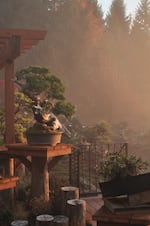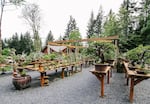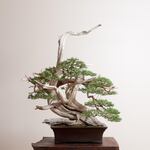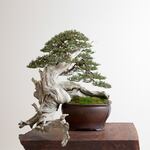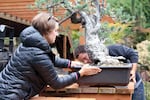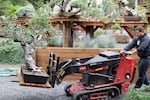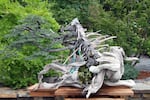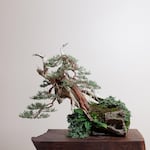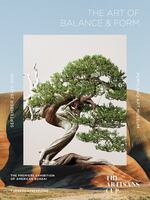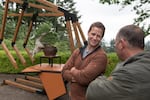
Ryan Neil's quest to elevate bonsai from a gardening craft to a high art is on display at the Japanese Garden from May 21–June 19.
Arthur Hitchcock
Story update: The exhibition "American Bonsai: The Unbridled Art of Ryan Neil" runs at the Portland Japanese Garden May 21–June 19, 2016.
When most Americans think of bonsai — the craft of pruning and shaping small trees — they probably think of an ancient gardening craft practiced by lovers of Japanese culture.
Ryan Neil thinks it’s anything but.
With a story ripped from the movie "The Karate Kid," he founded Bonsai Mirai, a leading international school in the hills outside Portland, and he's partnered with cutting-edge architects and designers in an effort to make bonsai cool for a new generation.
From Sept. 25–27, they're staging an ambitious exhibition of bonsai from around the country at the Portland Art Museum called The Artisans Cup with design help from Skylab Architecture. Their goal: to elevate bonsai into a contemporary art form worthy of, well, museums.
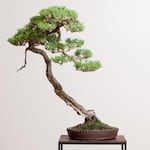
A Japanese Black Pine
Courtesy of Bonsai Mirai
Bonsai Mirai, much like the trees it cultivates, is on the edge between civilization and wilderness. Outside St. Helens, it's at the end of a long country road, butting against a forest.
When I drove out to Bonsai Mirai on a drizzly afternoon, Neil was carefully maneuvering a large bonsai plant using a small forklift–like machine called a Dingo through hundreds of tightly packed bonsai trees sitting in rows on tables and on the ground. Some are up to 2,000-years-old, and most are worth thousands of dollars.
And Neil owes it all to “The Karate Kid.” Unlike most children of the 80s who enrolled in karate classes and dressed as skeletons for Halloween, Neil obsessed over Mr. Miyagi’s bonsai collection. He bought books and started styling his own trees.
"Once the door is open, it's like a virus," he said. "It multiplies and spreads and consumes your entire existence."
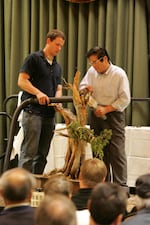
Neil with his teacher, famed Japanese bonsai master Masahiko Kimura. He was known as the "Magical Technician of Kindai Shuppan."
Courtesy Bonsai Mirai
Neil wanted to move to Japan when he finished high school, but his parents insisted on college, so he studied horticulture. It was all with a singular goal: to study with Masahiko Kimura.
"He's really the father of modern bonsai," said Neil. "He took traditional bonsai and literally turned it on its head. I mean, turned trees upside down. No one even knew that was possible. And he was the one from age 12, he was the one I was going to study with."
A mentor took Neil to Japan and introduced him to Kimura, who laughed at the idea of taking on an American student. So Neil wrote him a letter. It went unanswered. He wrote another letter. Again, unanswered. He continued to write every month for two years until finally, a month before graduation, Kumura agreed to let him come.
Neil spent six years under Kimura’s eye.
"As cliché as it sounds, it was kind of Karate Kid-ish," he recalled. "I remember the first Christmas, we’re building a fence on Christmas Day, and I was like, you just couldn't make this stuff up. He was very very hard on us. It was a very almost old world feudalistic manner of education."
Of the six apprentices, Neil was the only one to finish and is one of only a dozen people, and the only westerner, to complete the full apprenticeship.
He was driven by the idea to create a professional, modern bonsai culture in America, one that could support artists at every level, from the people who find the trees in the wild to the ceramicists who make the pots.
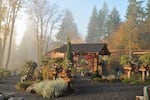
So he created Bonsai Mirai, and started teaching and working, applying the high standards of Japanese bonsai to American trees instead of the traditional Japanese ones in a quest to pioneer a contemporary American style.
"We have a lot more youth and less tradition," he said. "We've got a pretty keen eye for innovation. And our environment is wild and untamed, and our material reflects that."
We ventured into the garden to look at examples of this American style. We stopped in front of the tree he'll have at the Artisans Cup. It's an Engelmamn Spruce, some three feet tall, that looks like it was pulled from a windy mountainside. All its branches sweep to the left. So instead of planting the tree in a pot, Neil planted it in a piece of curling driftwood that looks like the wind.
"You're always trying to express environment," he said. "I think this is an attempt to deviate from expressing the environment and more focusing on the element that created the tree. It will be interesting to see how people respond of this."
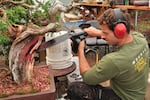
Bonsai artist Ryan Neil sculpts a tree with a chainsaw in his Bonsai Mirai workshop.
Courtesy Bonsai Mirai
Ryan Neil’s quest to modernize bonsai is helped by his wife, Chelsea. She brings the business savvy to Neil’s bonsai geekery. She hired one of Portland's hippest design agencies, OMFG Co., to brand Bonsai Mirai and formed a partnership with the award-winning photographer Chris Hornbecker (his work is well-known by Portlanders: he did the Timber's Army billboards).
Now Neil teaches classes, trains apprentices, sells to collectors, and helps maintain collections for public institutions, such as San Marino’s Huntington Library and Los Angeles’s Botanic Gardens.
After decades of following Japanese tradition, there's been a major shift in the US bonsai community in the past five years, according to Aarin Packard, the curator on the Pacific Bonsai Museum south of Seattle.
"It's primarily due to Ryan's efforts," Packard said, complimented by the museum's work (it's the only autonomous bonsai museum in the country) and a growing body of artists and collectors. "The Pacific Northwest is becoming an epicenter for a new American bonsai movement."
But still Neil thought the ecosystem needed something else. He wanted to create an event that would lift the bar for everyone: the Artisans Cup
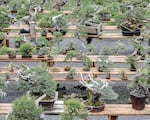
Most of the trees are several hundred years old, but some are up to 2,000.
Courtesy Bonsai Mirai
"If you look at that Kokufu exhibition in Japan, the national exhibition of bonsai, it’s held of the National Museum in Ueno," he said. "And we go to Europe to work quite a bit at some of the major exhibitions and a lot of those are held an extremely beautiful art venues. So in the United States it doesn't make sense to have it held at a hotel near an airport in a conference room. It needs to be put into an environment where it can be appreciated as art.
So Ryan and Chelsea Neil booked the Portland Art Museum. To add another layer of design legitimacy, they cold-called Portland’s internationally recognized architecture firm Skylab, which signed on to create a modular exhibition to display the trees.
"We feel a real kinship with the objectives of the Artisans Cup," said Skylab design director Daniel Meyers. "There's a beautiful melding between a reverence and respect for a really deep and long term tradition and an eye to the future. They’re really thinking about how to apply and adapt those traditions to a modern context, and that's something we're really interested in doing in our work."
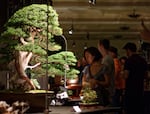
Organized by Ryan Neil, the Artisans Cup showcased 70 bonsai trees at the Portland Art Museum to try to elevate bonsai into the world of high art.
Courtesy of the Artisans Cup
The show features 70 trees selected from 300 submissions. All of the panel discussions have sold out and they've already sold 1000 tickets, with people coming from around the world. But the question remains for the Neils: will there be an audience beyond the bonsai community that is willing to embrace it as a contemporary art form?
"We'd eventually like to take it to MOMA in New York or the Guggenheim or the Whitney are one of these very major art facilities," said Neil. "And I think we'll probably get there.
They already have an invitation to stage the Artisans Cup in Sydney in 2020.

